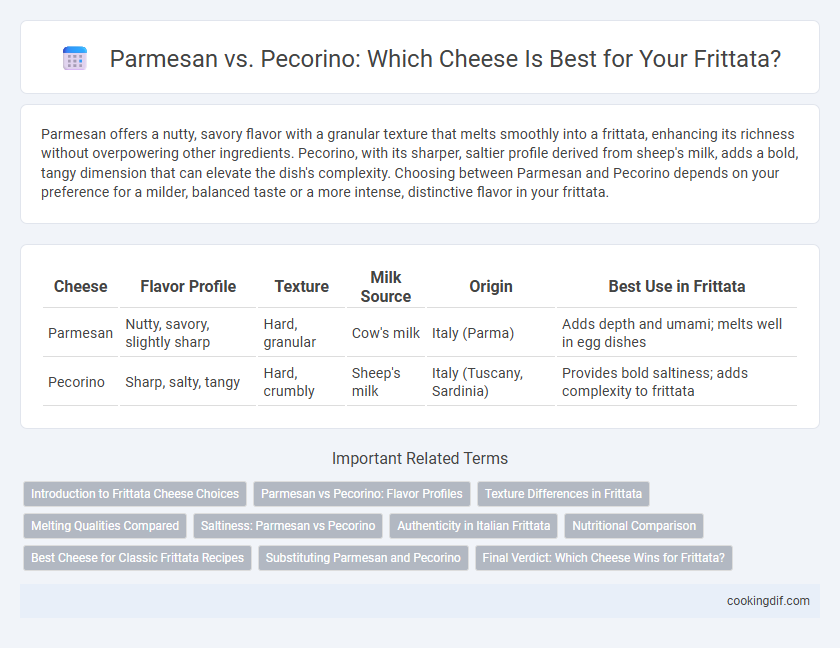Parmesan offers a nutty, savory flavor with a granular texture that melts smoothly into a frittata, enhancing its richness without overpowering other ingredients. Pecorino, with its sharper, saltier profile derived from sheep's milk, adds a bold, tangy dimension that can elevate the dish's complexity. Choosing between Parmesan and Pecorino depends on your preference for a milder, balanced taste or a more intense, distinctive flavor in your frittata.
Table of Comparison
| Cheese | Flavor Profile | Texture | Milk Source | Origin | Best Use in Frittata |
|---|---|---|---|---|---|
| Parmesan | Nutty, savory, slightly sharp | Hard, granular | Cow's milk | Italy (Parma) | Adds depth and umami; melts well in egg dishes |
| Pecorino | Sharp, salty, tangy | Hard, crumbly | Sheep's milk | Italy (Tuscany, Sardinia) | Provides bold saltiness; adds complexity to frittata |
Introduction to Frittata Cheese Choices
Parmesan and Pecorino are popular cheese choices for frittatas, each bringing unique flavors that enhance the dish. Parmesan offers a nutty, savory profile with a firm texture, while Pecorino provides a sharper, saltier taste due to its sheep's milk origin. Selecting between Parmesan and Pecorino depends on the desired flavor intensity and regional preference, impacting the overall frittata experience.
Parmesan vs Pecorino: Flavor Profiles
Parmesan cheese offers a nutty, savory flavor with a granular texture that melts smoothly in frittatas, enhancing the dish with umami richness. Pecorino, made from sheep's milk, presents a sharper, saltier taste and a crumbly texture, adding a robust and tangy complexity. Choosing Parmesan emphasizes a mellow depth, while Pecorino delivers a bold, piquant punch to the frittata's overall flavor profile.
Texture Differences in Frittata
Parmesan provides a granular, crumbly texture that melts smoothly into a frittata, enhancing its creaminess without overpowering other ingredients. Pecorino offers a firmer, saltier bite with a slightly oily texture that creates a more pronounced, robust flavor and adds a subtle chewiness to the dish. Choosing between Parmesan and Pecorino affects the frittata's mouthfeel, with Parmesan delivering a softer finish and Pecorino contributing a denser, more textured experience.
Melting Qualities Compared
Parmesan cheese exhibits a smoother melting quality, creating a creamy texture perfect for a velvety frittata. Pecorino, while flavorful and sharp, tends to melt less uniformly, resulting in a slightly grainier consistency. For a frittata that emphasizes a rich, cohesive melt, Parmesan generally outperforms Pecorino in melting behavior.
Saltiness: Parmesan vs Pecorino
Parmesan and Pecorino differ notably in saltiness, impacting flavor profiles in frittatas. Parmesan offers a balanced, savory saltiness with nutty undertones that enrich without overpowering. Pecorino is saltier and sharper, lending a more pronounced briny kick that intensifies the frittata's taste.
Authenticity in Italian Frittata
Parmesan offers a nutty, subtly sweet flavor that enhances the creamy texture of a traditional Italian frittata, while Pecorino provides a sharper, saltier profile that reflects rustic regional authenticity, particularly in central and southern Italy. Authentic Italian recipes often favor Pecorino for its bold taste, giving the frittata a distinctive character rooted in local terroir and culinary tradition. Selecting Pecorino supports the dish's historical integrity, whereas Parmesan introduces a more universally familiar, milder cheese experience.
Nutritional Comparison
Parmesan cheese provides a higher amount of calcium and protein per serving, making it a strong choice for bone health and muscle repair in frittata recipes. Pecorino, derived from sheep's milk, typically contains more fat and sodium, contributing to a richer taste but requiring moderation for heart-conscious diets. Both cheeses offer essential nutrients, but Parmesan's lower fat content and higher calcium level make it a nutritionally advantageous option for balanced meals.
Best Cheese for Classic Frittata Recipes
Parmesan offers a nutty, savory flavor and melts smoothly, making it ideal for classic frittata recipes seeking a balanced, rich taste. Pecorino, with its sharper, saltier profile and crumbly texture, adds a bold, tangy punch but can overpower delicate ingredients. For traditional frittatas, Parmesan is often preferred for its ability to enhance flavor without overwhelming the dish's subtle egg base.
Substituting Parmesan and Pecorino
Parmesan and Pecorino cheeses differ in flavor and texture, making them distinct choices for frittata recipes. Parmesan offers a nutty, slightly sweet taste with a granular texture, while Pecorino provides a sharper, saltier profile from sheep's milk, adding boldness to the dish. Substituting Parmesan with Pecorino enhances the frittata's intensity, but reducing the amount slightly helps balance saltiness, preserving the recipe's harmony.
Final Verdict: Which Cheese Wins for Frittata?
Parmesan offers a nutty, salty flavor that melts smoothly into the eggs, enhancing the frittata's texture with a subtle richness. Pecorino, made from sheep's milk, brings a sharper, tangier profile that adds a bold depth and saltiness, creating a more pronounced taste. For a classic, balanced frittata, Parmesan is often preferred for its mellow complexity, while Pecorino suits those seeking a robust, savory punch.
Parmesan vs Pecorino for cheese selection Infographic

 cookingdif.com
cookingdif.com